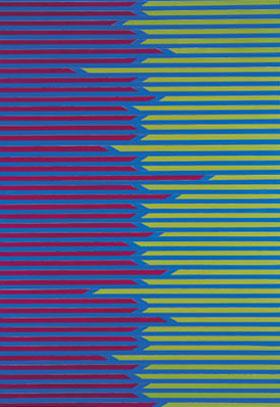Hordur Agustsson
dal 20/3/2002 al 5/5/2002
Segnalato da
20/3/2002
Hordur Agustsson
i8 Gallery (old location), Reykjavik
A Search for Certainties. The works shown at i8 were all made between 1955 and 1970. In the upper space of the gallery Agustsson's large paintings/drawings realised with tape will be shown while a selection of his drawings and graphics will be shown in the basement.

A SEARCH FOR CERTAINTIES
On Thursday March 21 at 5pm, an exhibition with works by Hordur Agustsson
will open at i8 gallery.
Hordur Agustsson (b. 1922) is known for his art, design and his special
interest in the heritage of Icelandic Architecture. In 1998 Agustsson's book
Icelandic architectual heritage I, history of housebuilding from 1750 to 1940
was published, for which he received the Icelandic Literature reward.
The works shown at i8 were all made between 1955 and 1970.
In the upper space of the gallery Agustsson's large paintings/drawings
realised with tape will be shown while a selection of his drawings and
graphics will be shown in the basement.
It is oftentimes said that the present always changes the past. In this
country, as well as on the European continent, artists have once again taken
to paring their art down to the bare formal minimum or to camouflaging it as
aestheticized data. In this case, the art historical antecedents for this
resurgence, the heritage of Mondrian or Malevich, need not be invoked, since
it is essentially a product of our time.
This new spare and minimal art can be seen as a bulwark of a kind, anattempt
to resist the manifold pressures being applied to modern creative
sensibilities: the relentless media pollution that cuts into our time and
space for reflection, the temptations to conform to the edicts of a
market-driven art scene, the tendency, fuelled by postmodernism, to belittle
anything that smacks of "idealism or anyone seeking "absolute truths and
the
proliferation of impotent theorizing.
As often happens, the rediscovery of an older trend, in this case the
minimalizing and conceptualising process, has led to a re-evaluation of
hitherto neglected art and artists.
One particularly gratifying result of this current "revisionism is the
increasing interest in Hörður Ãgústsson's works from 1955-1975. Outside
experts have regarded these works as significant examples of Nordic Concrete
Art, as well as preludes to international Minimalism.
The current
exhibition
at the I8 Gallery is a celebration of this new appreciation of the artist's
work, as well as his 80th birthday.
In the past, Mr. Ãgústsson refused to categorize these works as "concrete
or
minimalist, preferring instead to talk about them as stages on a personal
journey towards knowledge and intellectual fulfilment. It is an unusual
journey, at least in the context of Icelandic art.
It had its beginnings in the early Forties, when Mr. Ãgústsson set out as a
student of engineering and architecture. This led to an interest in the
Bauhaus, with its emphasis on rational thought and purity of conception.
Subsequently he was drawn to the theories of Renaissance writers such as
Luca
Pacioli and Leon Battista Alberti, both of whom were concerned with ideal
proportion and the harmony of forms and colours. On a brief visit to
Florence
in 1948, Mr. Ãgústsson came across a book that seemed to encapsulate all
these
theories, Matila Ghyka's "Le Nombre d'Or, published in 1931 with a preface
by
Paul Valéry. For years to come, this book was to sustain him in his quest.
Thus, when Post-War Concrete Art, often termed Geometric Abstraction, hit
Iceland in the early Fifties, Mr. Ãgústsson was perhaps better prepared for
it
than any other Icelandic artist.
Again, I don't believe he ever saw Geometric Abstraction as a cohesive
"style, but rather as an instrument of research that would help him to
understand the inner workings of the work of art as well as the governing
logic of thought. "I needed to look forthe fundamentals, basic forms,
primary
colours, and test their expressive potential to the full Mr. Ãgústsson said
in a 1983 interview. This was a search without any hope of finite answers,
rather an unending process in what the artist termed his "form factory.
Not until the mid Sixties did Mr. Ãgústsson let on that his search for
fundamentals and formal perfection might be more than an expression of
hard-headed rationalism, that it also contained within itself a longing for
some sort of religious certainty, what he himself once called "intimation of
the innermost centre of being. By then he had already produced a handful of
semi-figurative works with a strong religious connotations.
Given Mr. Ãgústsson's long-standing interest in medieval studies, I would
suggest that there was a direct connection between this longing and the
writings of medieval philosophers such as St. Thomas Aquinas and the
Neoplatonists. Beauty lies in proportion, says St. Thomas, in the harmony of
forms and colours. Furthermore, the Neoplatonists maintained that, since the
forms of all created things proceed ultimately from God, beauty in the
material world is a reflection of the divine.
If we allow ourselves to juxtapose St. Thomas's "beauty and Mr. Ãgústsson's
"centre of being, we may discover a new, and ultimately more rewarding, way
of interpreting these challenging works of art.
Adalsteinn Ingólfsson
Opening on Thursday March 21 at 5pm
i8 is open Tuesdays to Saturdays from 1pm to 5pm
i8
Klapparstig 33
101 ReykjavÃk
Tel: + 354 551 3666 / 690 4960
Fax: + 354 551 3666



